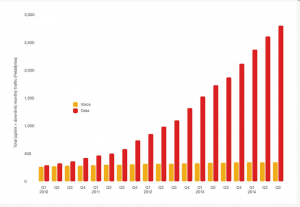Google Wireless’ focus of late has propelled the company once again into the forefront of mobile technology, this time targeting wireless data delivery as a mobile virtual network operator (or MVNO). The company is looking to combine incumbent carrier networks plus Wi-Fi, with the potential to offer new pricing that will alter the calculus of the industry going forward.

The Wall Street JournalWorldwide total uplink and downlink monthly traffic in Petabytes source: 2015 Ericsson Mobility Report reported yesterday that the Google Wireless plan includes deals already in place with Sprint and T-Mobile, news that updates the original report (rumors) of the deal first covered in Investors Business Daily on January 22nd.
The Google Wireless plan looks to leverage existing coverage of both Sprint and T-Mobile networks, and adds the growing number of nationwide Wi-Fi hot spots to optimize mobile content delivery (including voice) in ways a single carrier (read this as AT&T and Verizon) cannot. The company is also working on new technology that will analyze signal strength (and ultimately cost), to deliver a hybrid wireless connection to mobile devices that should boost efficiency and lower cost to consumers.
Giving weight to the viability of the Google plan, New York based Cablevision, said in a separate announcement that it will launch Freewheel, a Wi-Fi only mobile phone service as early as next month,. Cablevision will use, in part, its 1.1M Wi-Fi hot spots already deployed in the greater New York city area and built since 2007. It can deliver unlimited talk, text and data for just $9.99/month to its existing NY City home ISP (internet service provider) customers. No subscription? No problem, just pay $29.95/mo for the service and you are connected to its Wi-Fi only service. Cablevision, which is the eighth largest cableTV provider in the US, will probably make the Wi-Fi portion of Google’s vision a reality first, helping to prove and roll out the concept.
The Google Wireless idea of creating a wireless carrier network based on Wi-Fi is not new. Republic Wireless, based out of Raleigh, NC, has been working on its hybrid mobile network since early 2010. It has completed its beta roll-out and, as of November 2014, offers a service to customers restricted to a Moto phone of the G, E or X vintage ranging in price from sub $100 to $300. The Moto G is also being offered on the Cablevision Wi-Fi phone system. Interestingly, Motorola wireless devices, now part of Lenovo, was formerly owned by Google. Other companies working in this direction include FreedomPop and Scratch Wireless.
But the so called hybrid calling technology that uses wireless 3G and 4G plus Wi-Fi is not a “slam-dunk” for any of these carriers. A CNET article on the topic highlighted the problem of Wi-Fi to cell hand-off as a major problem, and perhaps one that kept Google from delivering on its previously announced October 2014 launch date.
The long term effects of the two moves are still under review by the wireless community. Some have cast doubt that Google can provide the hybrid service directly to customers in a manner more efficient than is already being done by the mainstream carriers, including those that license bandwidth and resell it on pay-as-you go plans. Still, any move by the giant Google in the space bears watching, and any introduction of new technology that can reshape the delivery landscape must be taken seriously.
There’s another interesting point, already some 90% of mobile data traffic in the US is delivered via Wi-Fi networks, according to Cisco Systems’ review of the industry in 2013. This is a number that’s clearly not reflected in current pricing (consider a typical monthly internet bill versus a wireless phone bill.) We think that Google, Cablevision and others moving into this space will indeed put pressure on the largest carriers, AT&T and Verizon. It increases choice in the market place, and perhaps most importantly, can lower the cost of those at the bottom of the economic ladder with new affordable wireless access alternatives with the potential for long-term global benefits. – Steve Sechrist

